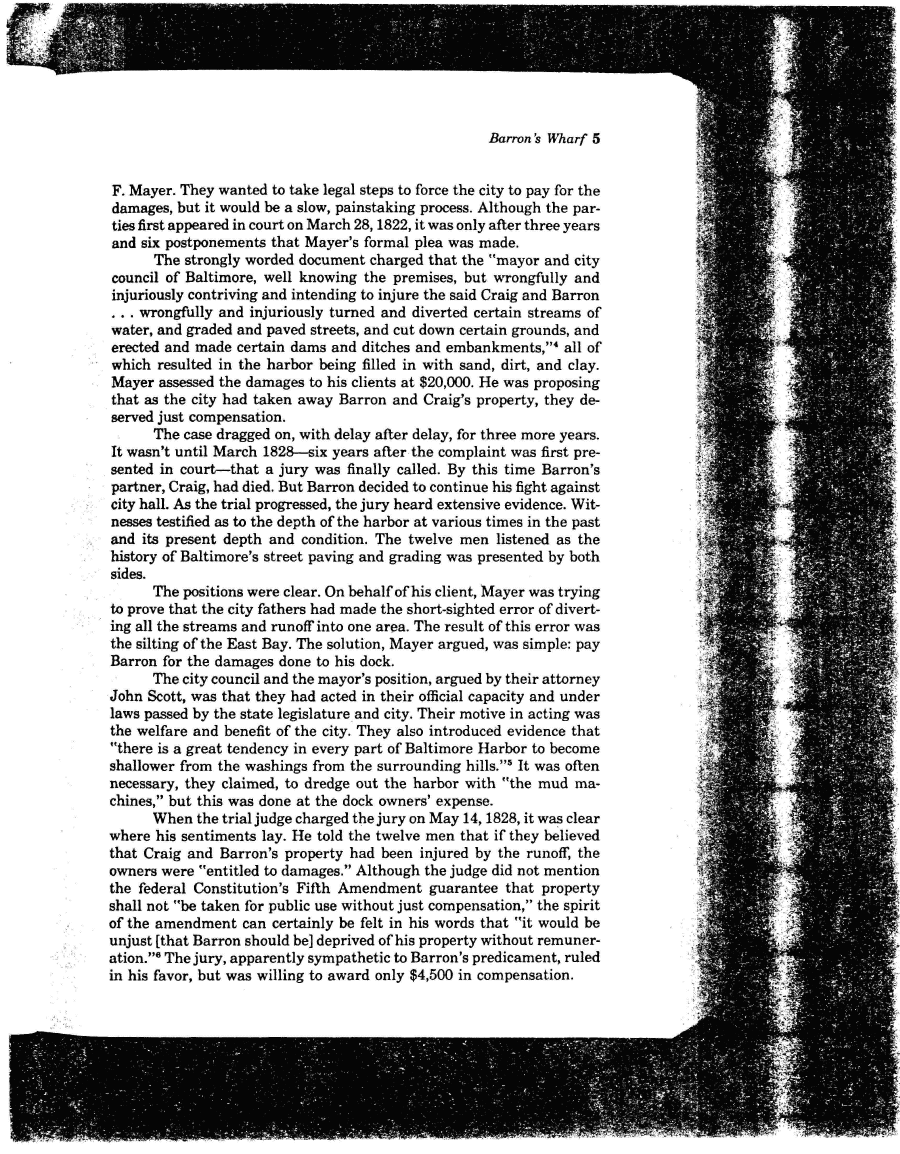|
Barren's Wharf 5
F. Mayer. They wanted to take legal steps to force the city to pay for the
damages, but it would be a slow, painstaking process. Although the par-
ties first appeared in court on March 28,1822, it was only after three years
and six postponements that Mayer's formal plea was made.
The strongly worded document charged that the "mayor and city
council of Baltimore, well knowing the premises, but wrongfully and
injuriously contriving and intending to injure the said Craig and Barron
. . . wrongfully and injuriously turned and diverted certain streams of
water, and graded and paved streets, and cut down certain grounds, and
erected and made certain dams and ditches and embankments,"4 all of
which resulted in the harbor being filled in with sand, dirt, and clay.
Mayer assessed the damages to his clients at $20,000. He was proposing
that as the city had taken away Barron and Craig's property, they de-
served just compensation.
The case dragged on, with delay after delay, for three more years.
It wasn't until March 1828—six years after the complaint was first pre-
sented in court—that a jury was finally called. By this time Barren's
partner, Craig, had died. But Barron decided to continue his fight against
city hall. As the trial progressed, the jury heard extensive evidence. Wit-
nesses testified as to the depth of the harbor at various times in the past
and its present depth and condition. The twelve men listened as the
history of Baltimore's street paving and grading was presented by both
sides.
The positions were clear. On behalf of his client, Mayer was trying
to prove that the city fathers had made the short-sighted error of divert-
ing all the streams and runoff into one area. The result of this error was
the silting of the East Bay. The solution, Mayer argued, was simple: pay
Barron for the damages done to his dock.
The city council and the mayor's position, argued by their attorney
John Scott, was that they had acted in their official capacity and under
laws passed by the state legislature and city. Their motive in acting was
the welfare and benefit of the city. They also introduced evidence that
"there is a great tendency in every part of Baltimore Harbor to become
shallower from the washings from the surrounding hills."5 It was often
necessary, they claimed, to dredge out the harbor with "the mud ma-
chines," but this was done at the dock owners' expense.
When the trial judge charged the jury on May 14,1828, it was clear
where his sentiments lay. He told the twelve men that if they believed
that Craig and Barren's property had been injured by the runoff, the
owners were "entitled to damages." Although the judge did not mention
the federal Constitution's Fifth Amendment guarantee that property
shall not "be taken for public use without just compensation," the spirit
of the amendment can certainly be felt in his words that "it would be
unjust [that Barron should be] deprived of his property without remuner-
ation."6 The jury, apparently sympathetic to Barren's predicament, ruled
in his favor, but was willing to award only $4,500 in compensation.
|

